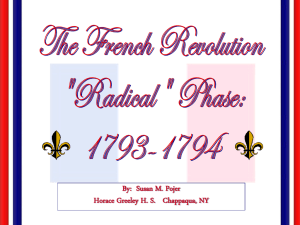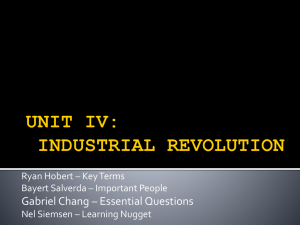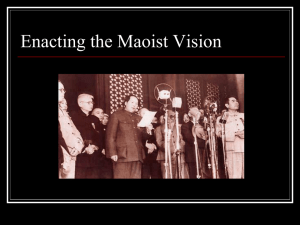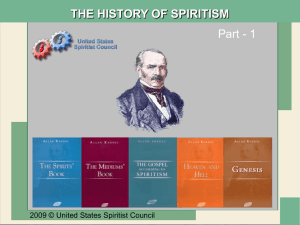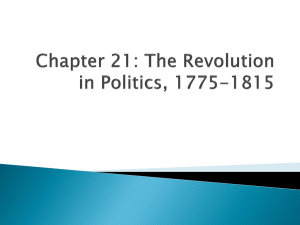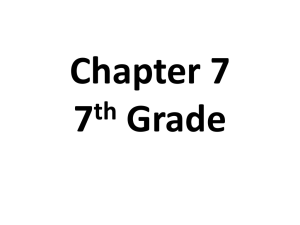The French Revolution in Britain
advertisement
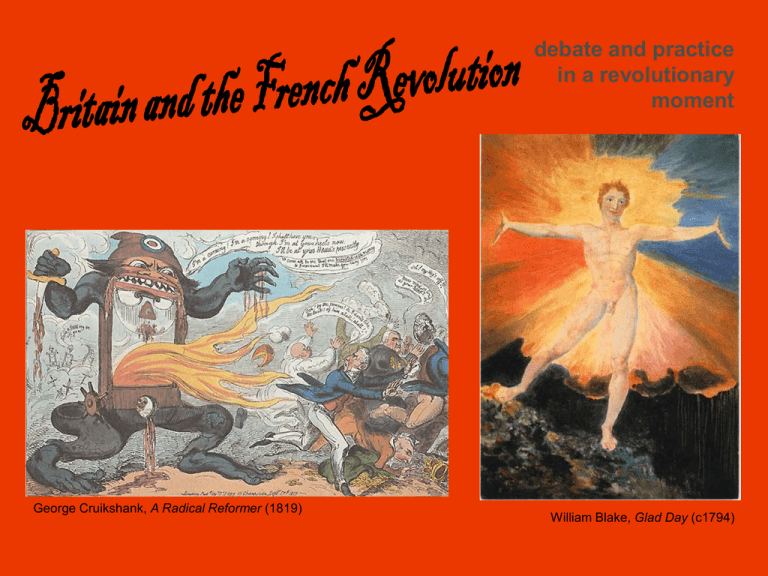
debate and practice in a revolutionary moment George Cruikshank, A Radical Reformer (1819) William Blake, Glad Day (c1794) Celebration of Glorious Revolution • 1788-89: Centennial of 1688 • Celebration of the mixed constitution One of many pieces of celebratory literature in 1788 Initial Impact of the French Revolution • British: FR adopting a Constitutional Monarchy • Support from politicians (Fox) and writers • William Wordsworth, Samuel Taylor Coleridge, William Blake Coleridge in 1795 The Reaction in Great Britain • Abolition of feudalism, privilege, monarchy; disestablishment of Church • Defects in British system? • Popular democratic societies A French revolutionary print: “The End of Privileges” (1789) The Pamphlet War • Edmund Burke (1729-97) • Irish politician and political writer. • Reflections on the Revolution in France (1790) • Themes – First principles vs history – Theory vs. practice – Mechanical vs organic structures James Gillray, Smelling out a Rat;– or – The Atheistical-Revolutionist disturbed in his Midnight “Calculations.” (1790). Burke was notorious for his glasses. The Pamphlet War Gillray cartoon: Paine taking the measure of the crown. Paine had been a stay-maker. • Thomas Paine (17371809) – Rights of Man, 1791. – Deficiencies of society of privilege – Human reason applied to gov’t. • Mary Wollstonecraft, Vindication of the Rights of Women (1792) Feminist Mary Wollstonecraft The Pamphlet War • John Thelwall – From political rights to social welfare • Thomas Spence – Communitarian economies – Form and media John Thelwall Examples of Spence’s tokens Radicalism • Association Movement (1780s) • Society for Constitutional Information: Middle Class 1780 – John Cartwright – Goals? • London Corresponding Society, 1792 – Social stratum: Thomas Hardy – Goals? – A British national convention and new constitution? Gillray’s unsympathetic cartoon showing a mid-1795 LCS mass meeting outside London Regicide and Terror: the Jacobins in Power • Flight to Varennes, Je ‘91 • The Republic, Sept. ‘92 • Jacobins take power, Spring ‘93 – Committee of Public Safety • Fear of counterrevolution • Political revolution social revolution M. Robespierre, key figure on the CPS Contemporary image of the arrest of Louis XVI at Varennes, June 1791. The Shadow of the Guillotine • Slippery slope reaction • Issues tabled: Parliamentary Reform; Catholic Emancipation; Abolition of Slave Trade. • Revolt of the intellectuals: Wordsworth, Coleridge, Robert Southey. Gillray: The Blood of the Martyr’d, Crying for Vengeance (1793) Repression • Fear of cross-class collaboration • Attack on radical print networks – Royal Proclamation against seditious writings 1792 – Paine tried in absentia (1792) • British Convention (Edinburgh, fall 1793) • 1794 Treason Trials • Government propaganda: Anti-Jacobin Review • Reevite Loyalist Societies (late ’92) Evidence of radical arming brought forward in Hardy’s trial (Oct. 1794) Joseph Gerrald, LCS delegate to the British Convention at Edinburgh. Transported to Australia in 1794. Crisis of 1795 George Cruikshank, A Free Born Englishman, the Envy of the World! • 1795 food riots • Monster meetings (up to 100,000 near London) • Riot against King’s carriage • Two Acts, Nov. 1795 – Treasonable Practices Act – Seditious Meetings Act • Anti-Combination Act 1799 Gillray satirizes the gov’t Opposition by making them the assassins taking aim at Geo. III (1795) War • • • • • Pitt’s assumptions concerning peace Nov. 1792: Edict of Fraternity Nov. ’92: French occupy Belgium 1793 War against the French Revolution France promised aid to Irish and English Radicals French volunteers answer the call to arms Impact on Government • Pitt’s policies of financial austerity abandoned. • Financial assistance to allies. • Increased surveillance: local and central government • Controversial policies and legislation William Pitt (the Younger) Impact on Parliamentary Politics • Disintegration of the Whig Party – Old Whigs vs Fox and the New Whigs – Fox’s support for the Revolution – Charles Grey: the Friends of the People • Burke, the Portland Whigs (June 1794) Charles James Fox Pitt vs Fox • Fox identified with support for – The Revolution – Parliamentary Reform – Greater levels of popular participation in politics. • Fox identified with opposition to – Power of Crown – Government “despotism” – Continuing the war with France Fox (top) taking aim at Lords and Commons; and (bottom whipping Wm. Pitt). Pitt vs Fox • Pitt identified with opposition to – French Revolution – Parliamentary Reform • Pitt identified with support for – British constitution – Monarchy – Tradition and hierarchy – Strong executive – Support for war Pitt (top) running roughshod over British liberties, and (bottom) on trial after the British Revolution Irish Rebellion 1798 • United Irishmen, 1791 – Constitutional reforms based on French ideals – Leaders: Wolfe Tone and Lord Edward Fitzgerald, Fox’s cousin. • Secular republic to reconcile Protestants and Catholics, and separate from Britain – 1793: Society driven underground – 1795: planned insurrection; FR help – 1798: insurrection--largely rural disorder--suppressed by British army. 30,000 killed • New South Wales Wolfe Tone Irish Union • Irish government had failed to prevent rebellion • Westminster Government required greater control to maintain order and prevent a French landing • Catholic rights more achievable under Union? • Act of Union, 1800 One of many atrocities during the ’98: prisoners trapped in a burning church Conclusion • Nationwide philosophical debate • Expansion of political sphere – Print networks; mass mobilization; Volunteer Associations • Reaction triumphant – “Patriotism” articulated as conservatism – Split the Whig opposition and strengthened the (Tory) government • Heritage of working-class activism 1800s • Ideas + famine created social unrest – Britain, 1815-1848

